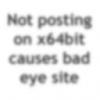Step 1: Perform an administrative installation
1. Insert the Office System (2003) CD into your drive, from the "Start" button select "Run" and type
F:\OFFICE\setup.exe /a
Notice there is a space between the "setup.exe" and the "/".
This is going to start the install process of Office 2003. You'll be presented with the option of where you want the files to go. (I chose "D:\Office cd"), and you'll be asked to enter your CD key.
2. After entering the CD key, you'll be presented with the End User License Agreement. Accept their then continue.
3. It's going to appear to be installing, but in fact your files are being copied over to your hard drive.
4. The completion window will pop up and the entire Office 2003 CD is now copied to your hard drive.
5. Take a look at the folder's properties, it should be approximately 624mb in size (that's for Office Professional Enterprise Edition 2003).
Step 2: Extract the Service Pack files
1. Locate the SP1 file (see the Prerequisites section above). The file name should be
Office2003SP1-kb842532-fullfile-enu.exe
2. Extract the .MSP files from within the SP1 download. You can do so by using a 3rd party extraction tool such as WinZip or WinRAR.
or, if you want, you can use this command:
D:\Office2003SP1-kb842532-fullfile-enu.exe /t:g:\Office cdSP1 /c
(where D: is the path to where you've downloaded SP1 and D:\Office cdSP1 is the folder to where you'll extract the SP1 files. Use your own path if necessary)
Note: The above command is ONE line. Just copy and paste.
Step 3: Apply SP to the installation files
Start the "Run" command from your "Start" menu again. Enter the following command:
msiexec /p G:\Office2003SP1\MAINSP1ff.msp /a G:\Office2003\PRO11.MSI shortfilenames=true /qb
Where G:\Office2003SP1 is the path where the SP1 files are located, and G:\Office2003 is the folder where the Office 2003 files were copied. Just copy the above line and change the folder locations to ease your typing and reduce spelling mistakes.
Note: Please, please use your OWN drive letters and folder names...
This will update the core components.
Note that you will not receive any message telling you that the process was indeed successful.
Once that is done, you'll need to update the web components. Start the "Run" command from your "Start" menu again. Enter the following command:
msiexec /p G:\Office2003SP1\OWC11SP1ff.msp /a G:\Office2003\OWC11.MSI shortfilenames=true /qb
Where G:\Office2003SP1 is the path where the SP1 files are located, and G:\Office2003 is the folder where the Office 2003 files were copied. Just copy the above line and change the folder locations to ease your typing and reduce spelling mistakes.
Lamer note: Duh...
Again, note that you will not receive any message telling you that the process was indeed successful.
Step 4: Burn the files to a CD (optional)
Use you favorite CD-Burning software and burn the G:\Office2003 folder to a CD. You don't need instructions for that, do you?
Note that after slipstreaming SP1 the G:\Office2003 folder is approximately 630mb in size:

Office 2003 SP1 slipstream, works on SP2 also
Started by
tnctx02
, Jan 15 2006 09:49 PM
9 replies to this topic
#1
Posted 15 January 2006 - 09:49 PM
#2
Posted 16 January 2006 - 01:55 AM
Can someone help me, i'm a little confused...
what exactly does this accomplish for you?
what exactly does this accomplish for you?
#3
Posted 16 January 2006 - 06:11 AM
 RedInferno, on Jan 15 2006, 07:55 PM, said:
RedInferno, on Jan 15 2006, 07:55 PM, said:
Can someone help me, i'm a little confused...
what exactly does this accomplish for you?
what exactly does this accomplish for you?
I do this with my Office disk whenever a new SP is released. It slipstreams all the new releases for the office product into it so after it is installed, the SP is in already.
#4
Posted 16 January 2006 - 06:56 PM
Why would you want to reinstall Office everytime though?
#5
Posted 16 January 2006 - 07:03 PM
it means after a reinstall of XP or after having to reinstall office, its just one install, it patches all the problems and updates it.
#6
Posted 16 January 2006 - 10:40 PM
Yeppers, you are so very correct sir. And when you are doing this, the Administrative install is just placing all the files into a folder on your pc.
#7
Posted 16 January 2006 - 10:57 PM
i have sp2 slipstremed in with my windows xp  alot better then doing it seperate
alot better then doing it seperate
#8
Posted 17 January 2006 - 09:10 PM
yeah, i wouldn't go back to installing it seperate on a slow computer, it takes ages.
#9
Posted 17 January 2006 - 09:48 PM
I use nLite still to integrate all hotfixes into my XP also....sure cuts down the updating time!!
#10
Posted 18 January 2006 - 06:50 AM
Ah yes, i know about that, it edits the CD as you say, really good for taking the bulk out of XP and increasing performance when you have limted money and resources.
I would say to people who have a spare slow pc at work or home to try it HERE
You can also use this to slipstream service packs but the manual tweak has its own advantages
I might try this with an old longhorn build
I would say to people who have a spare slow pc at work or home to try it HERE
You can also use this to slipstream service packs but the manual tweak has its own advantages
I might try this with an old longhorn build
0 user(s) are reading this topic
0 members, 0 guests, 0 anonymous users














